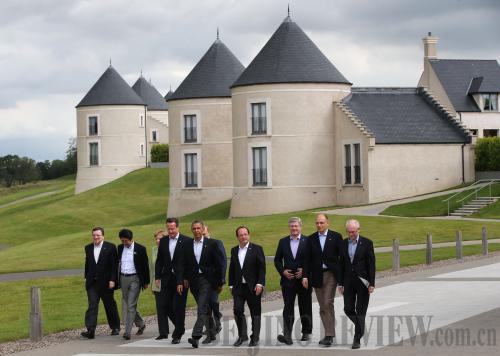|
 |
|
A COMMON MARKET: G8 leaders take a break during their summit at the Lough Erne resort in Northern Ireland, the UK, on June 18 (YIN GANG) |
In August 1941, British Prime Minister Winston Churchill and U.S. President Franklin Roosevelt signed the Atlantic Charter to fight against the Nazis. In June 2013, Europe and the United States decided once more to join forces by starting the Transatlantic Trade and Investment Partnership (TTIP). This time, their common enemy is the financial and economic crisis.
By establishing such an economic alliance, Europe and the United States hope to reverse their current economic downturn and create a new pattern of global trade. In other words, rich countries are seeking to become the rule-makers of the era once again.
Biggest free trade deal
On June 17, European Commission President Jose Manuel Barroso and U.S. President Barack Obama announced during the Group of Eight (G8) Summit in the UK the launch of the TTIP negotiations. The first round of the negotiations is scheduled for July 8 in Washington, D.C. According to the two leaders, the negotiations are expected to be completed before the end of 2014. Once a final agreement is reached, the largest free trade area on Earth will be formed.
Chinese observers pointed out that the TTIP is intended to inject "cardio tonic" into the sluggish U.S. and European economies, which have been badly affected by the financial and debt crises. However, they also predicted that reaching such an agreement will not be easy.
The double whammy of the global financial crisis and the debt crisis in Europe has put a heavy strain on both the United States and Europe. Starting TTIP negotiations will be the fastest and most effective economic stimulus for both sides, said Zhang Lin, a researcher on world economic and political studies with the Chinese Academy of Social Sciences.
Clearly, Europe and the United States are counting on the TTIP to reinvigorate their economies. According to their evaluation report, the established TTIP will cover 50 percent of the global GDP, and one third of the world's total trade volume. It is going to create $159.5 billion and $127.3 billion respectively for Europe and the United States every year. A European Commission report said the EU's annual average growth rate would increase from 0.5 percent to 1 percent after the TTIP is completed. And it could create 400,000 jobs in Europe, adding an extra 545 euro ($710) in income for EU families. British Prime Minister David Cameron stressed that the TTIP will also bring $113.6 billion every year to other countries outside the trade bloc.
Wang Yiwei, a professor with the European Studies Department at Renmin University of China, pointed out that the EU now considers the TTIP as the silver bullet for breaking down current economic and strategic dilemmas. He explained that investment, consumption and export are usually regarded as the troika that drives economic growth. But for now, expanding exports has become the EU's most hopeful tactic to revive its economy in the short term, said Wang. He said the EU's negotiation goal is to enhance two-way trade and investment with the United States, and encourage employment and economic growth.
A statement released by the White House on June 17 claimed the TTIP will be a grand, comprehensive and high-standard trade and investment agreement aiming to promote economic growth in Europe and the United States. According to the statement, Europe is the biggest export destination of the United States. In 2012, the United States exported products and services totaling $458 billion to the European market. Moreover, the two sides have established the most voluminous investment relationship in the world. In 2011, their mutual investment reached $3.7 trillion. The statement also listed eight targets of TTIP negotiations, concentrating on further opening markets, removing all trade tariffs and making new cooperation patterns and rules of global trade on a higher standard.
| 